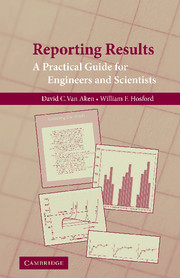Ashby, M. F. and Jones, D. R. H. (1981), Engineering Materials 1: An Introduction to Their Properties and Applications, Butterworth/Heinemann, Oxford.
Chauvenet, W. (1863/1961), “A Manual of Spherical and Practical Astronomy,” Vol. II, Theory of Astronomical Instruments: Method of Least Squares, Lippincott, J. B., Philadelphia/Peter Smith Publisher, New York, pp. 564–66.
Dieter, G. E. (1991), Engineering Design: A Materials and Processing Approach, second edition, McGraw-Hill Publishing Co., New York.
Dodd, J. S., ed. (1986), The ACS Style Guide: A Manual for Authors and Editors, American Chemical Society, Washington, D.C.
Hatch, J. F. (1984), Aluminum: Properties and Physical Metallurgy, ASM, Metals Park, Ohio.
Holman, J. P. (1989), Experimental Methods for Engineers, fifth edition, McGraw-Hill Book Co., New York, p. 63.
Johnson, L. G. (1951), “The Median Ranks of Sample Values in Their Population with an Application to Certain Fatigue Studies,” Industrial Mathematics, vol. 2., pp. 1–9.
Kilpatrick, J. J. (1984), The Writer's Art, Andrews, McMeel and Parker, Kansas City, Mo.
Kline, S. J. and McClintock, F. A. (1953), “Describing Uncertainties in Single-Sample Experiments,” Mechanical Engineering, January, p. 3.
Schubert, P. B. (1953), Pipe and Tube Bending, Industrial Press, New York.
Truss, L. (2003), Eats, Shoots and Leaves, Profile Books, London.
Webster's Standard American Style Manual (1985), Merriam-Webster Inc., Springfield, Mass.





